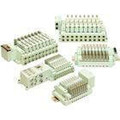Benefits of Secondary Batteries: Secondary batteries, or rechargeable batteries, are a cornerstone of modern efficiency and sustainability in industrial and commercial operations. Their ability to be recharged and reused multiple times not only reduces waste but also provides a reliable and cost-effective power solution.
Why Orange Coast Pneumatics? At Orange Coast Pneumatics, we understand the critical role that high-quality pneumatic system components play in your operations. Our commitment to excellence ensures that you receive the best equipment, tailored to meet your specific needs.
Understanding Secondary Batteries
Secondary batteries, also known as rechargeable batteries, distinguish themselves from primary batteries by their ability to be recharged and reused multiple times. This feature of primary cells not only makes them an environmentally friendly option but also a cost-effective solution in long-term applications.
The Science Behind Rechargeable Batteries
At their core, secondary batteries work on the principle of reversible electrochemical reactions. This allows them to store energy when connected to a power source and release it when needed. The technology behind these batteries has evolved significantly, leading to improved energy density, longevity, and safety.
Types of Secondary Batteries
Lithium-Ion Batteries
Lithium-ion batteries are renowned for their high energy density, making them ideal for applications where weight and space are crucial factors. They are commonly used in portable electronics, electric vehicles, and increasingly in large-scale energy storage systems due to their efficiency and longevity.
Lead-Acid Batteries
Lead-acid batteries are one of the oldest types of rechargeable batteries and are known for their reliability and cost-effectiveness. They are widely used in automotive applications, backup power systems, and industrial machinery.
Nickel-cadmium and Nickel-Metal Hydride Batteries
Nickel-cadmium (NiCd) and nickel-metal hydride (NiMH) batteries are known for their robust performance in extreme temperatures and are often used in applications where long cycle life is essential, such as in aerospace and military technologies.
Advantages of Secondary Batteries Over Primary Batteries
Secondary batteries offer several advantages over primary (non-rechargeable) batteries:
- Reusability: The ability to recharge reduces the need for frequent replacements, making them more sustainable and cost-effective in the long run.
- Higher Energy Density: Many secondary batteries, especially lithium-ion, have a higher energy density, providing more power per unit weight.
- Variety of Types: There is a wide range of secondary batteries available, each with unique characteristics that suit different applications.
Challenges and Developments
While secondary batteries offer numerous benefits, they also face challenges like capacity degradation over time chemical energy, and the need for safe disposal or recycling. Ongoing research and development in battery technology aim to address these issues, focusing on enhancing lifespan, reducing costs, and improving environmental friendliness.
Future Prospects
The future of secondary batteries looks promising with advancements in areas like solid-state batteries, which promise even higher energy densities and safety profiles. These developments are expected to further make secondary cells and revolutionize how energy is stored and utilized in both industrial and consumer applications.
Secondary Batteries vs. Primary Batteries
While primary batteries are used once and disposed of, secondary batteries offer a more sustainable and economical alternative. The ability to put rechargeable cells into a battery multiple times reduces the need for frequent replacements, thereby lowering operational costs and environmental impact.
Applications of Secondary Batteries
The versatility and efficiency of secondary batteries make them indispensable in a wide range of applications. From powering small consumer devices to driving large industrial machinery, these batteries are pivotal in numerous sectors.
Commercial Operations
In the commercial sector, the use of rechargeable lithium batteries is growing exponentially. They are essential in powering a multitude of devices, from smartphones and laptops to electric vehicles and drones. Their high energy density and long life span make them suitable for applications where longevity and reliability are paramount.
Industrial and Manufacturing Uses
In industrial settings, primary and secondary batteries are key to ensuring operational continuity. They are used in various machinery, emergency power systems, and energy storage solutions in manufacturing plants. Lead-acid batteries, known for their durability and high discharge rate, are commonly used in heavy machinery and forklifts.
Energy Storage Systems
Large-scale energy storage systems, crucial for managing renewable energy sources like solar and wind power, rely heavily on secondary batteries. These batteries store excess energy generated during peak production times and release it when demand is high, ensuring a steady energy supply and enhancing grid stability.
Telecommunications and Data Centers
Secondary batteries are essential in telecommunications for backup power to ensure uninterrupted service. In data centers, they provide emergency power to protect data integrity and maintain operations during power outages.
Healthcare and Medical Devices
In the healthcare sector, secondary batteries play a vital role. They are used in a range of medical devices, from portable monitors and diagnostic equipment to life-saving ventilators and defibrillators, where reliable power is a matter of life and death.
Transportation and Electric Vehicles
The transportation sector, especially electric vehicles (EVs), is increasingly dependent on secondary batteries, particularly lithium-ion batteries. These batteries are favored for electric vehicle batteries for their high energy efficiency and capacity, making EVs more viable and environmentally friendly.
Aerospace and Defense
In aerospace and defense, the reliability and longevity of secondary batteries are crucial. They are used in various applications, from powering equipment in spacecraft and satellites to providing energy solutions in remote military operations.
Consumer Electronics
Secondary batteries have revolutionized consumer electronics, enabling the development of portable, rechargeable devices like digital cameras, portable speakers, and wearable technology, enhancing convenience and mobility for users.
Environmental Monitoring and Renewable Energy
Secondary batteries are instrumental in environmental monitoring equipment, as energy storage devices allow for remote data collection and analysis. They also play a significant role in renewable energy systems, storing energy generated from solar panels and wind turbines, contributing to a more sustainable future.
Environmental Impact of Secondary Batteries
Sustainable Energy Solutions
Secondary batteries play a crucial role in promoting sustainability. Their reusability significantly reduces electronic waste and helps in conserving natural resources. Businesses adopting these rechargeable lithium battery battery systems are taking a step forward in their corporate social responsibility by minimizing their environmental footprint.
Recycling and Disposal
Proper disposal and recycling of secondary batteries are essential to prevent environmental harm. Programs and regulations surrounding primary battery recycling help in recovering valuable materials and ensuring safe disposal of hazardous components, further enhancing the eco-friendly aspect of using secondary batteries.
Cost-Effectiveness and Return on Investment
Long-term Financial Benefits
Investing in secondary batteries can yield substantial long-term financial benefits for businesses. The initial cost is offset by the longevity of the acid battery and reduced need for frequent replacements, leading to significant savings over time.
Energy Efficiency and Operational Costs
Secondary batteries are highly energy-efficient, offering more power per charge compared to primary batteries. This efficiency translates into lower operational costs, as less energy is required to move dry cells to achieve the same output, making them an economically viable choice for businesses.
Why Choose Orange Coast Pneumatics?
Benefits Revisited: Secondary batteries are not just energy sources; they are investments in your business’s efficiency and sustainability. Their long life span, coupled with the ability to be recharged multiple times, translates into significant cost savings and environmental benefits.
Why Orange Coast Pneumatics Stands Out: At Orange Coast Pneumatics, we specialize in providing top-quality equipment and accessories for your pneumatic systems. Our range of products is designed to integrate seamlessly with primary and secondary battery technologies, ensuring that you get the most out of your investment.
Take the Next Step: If you’re looking to enhance your operations with superior-quality equipment backed by reliable secondary battery solutions, contact our team today. Let us help you make a decision that powers your business forward.










